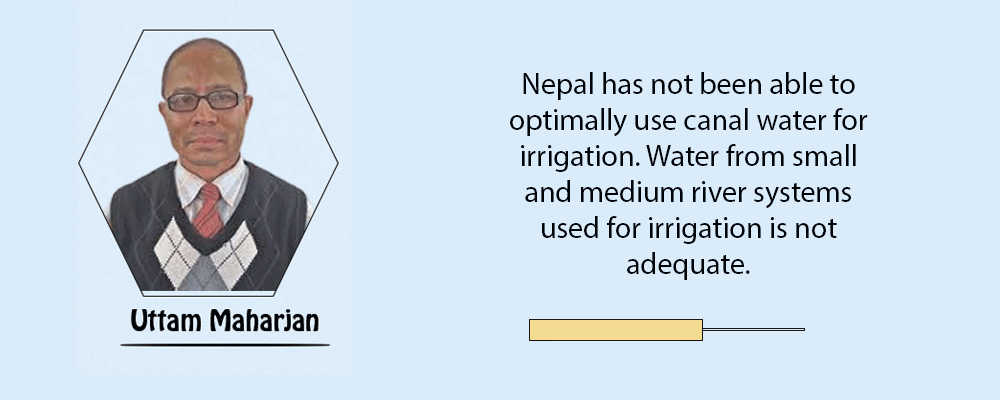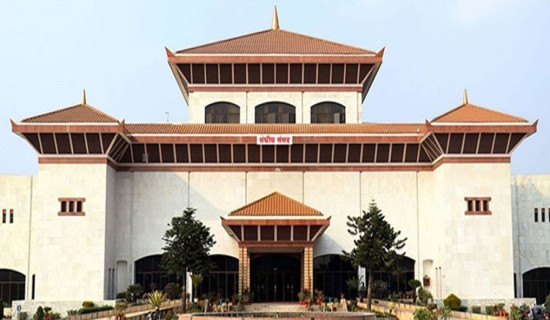- Wednesday, 21 January 2026
Expand Irrigation To Boost Production
Irrigation plays a pivotal role in agriculture, especially in countries whose agriculture is dependent on rain. In Nepal, too, irrigation is taken as an important component of agriculture. It need not be reiterated that the country’s agriculture depends on monsoon rains. The monsoon lasts from June to September and produces 75 per cent of annual rainfall.
Being an agrarian country with 65 per cent of the population engaged in agriculture and allied activities, Nepal has 2.6 million hectares of land under cultivation, out of which 1.8 million hectares are blessed with irrigation facilities. The Terai, the granary of the country, has 1.4 million hectares of land irrigated with the remaining 0.4 hectares of land lying in river valleys, upland valleys and terraces on hills and mountains. On a national scale, 38 per cent of land is irrigated all year round. Farmers manage 75 per cent of irrigated areas, whereas the Department of Irrigation manages the remaining 25 per cent of irrigated land.
Groundwater irrigation
Groundwater irrigation has also been practised in Nepal. Such irrigation is resorted to through shallow tube-wells. Such a practice has been in vogue in the Terai since the 1970s. However, the contribution of groundwater irrigation to the total irrigation system is limited. Groundwater irrigation covers 0.25 million hectares of land whereas it could be expanded to cover one million hectares of land. Less than 20 per cent of annual groundwater reserves are used for irrigation.
The development of irrigation in Nepal took place after the 1950s. Before that, only two public sector irrigation facilities were in place. One was the Chandra Nahar (canal) constructed in 1923 and the other was the Juddha Nahar constructed in the 1940s. The others were farmer-managed irrigation systems. There were farmer-managed small channels in hill districts and rain-fed agricultural practices in the Terai. The Department of Irrigation was set up in 1952. Gradually, small, medium and large canals were developed for irrigation purposes. The government has paid heed to the development of irrigation systems. However, the efforts are not sufficient.
Most irrigation systems depend on small or medium rivers. These rivers depend on rain. Major river systems have not been tapped for irrigation development. In fact, it is difficult to do so. It is an irony that despite having great potential for agricultural development in Nepal, agriculture has remained in a sorry state. As a result, even agricultural products, including foodgrain, have to be imported. There are several factors responsible for agricultural productivity remaining low. Irrigation facilities have not been extended to all arable land. Besides, agricultural inputs such as quality seeds and fertilisers are not readily available in the farming season. There is also lack of access to advisory services and marketing.
It is deplorable to note that agricultural products and fruit grown in remote areas keep on rotting, while the government imports such products from India. The government should take the initiative in bringing domestic agricultural products to the market rather than import such products from India or elsewhere. If domestic products are not adequate, imports should be made. Farmers should have access to advisory services so that they can increase both production and productivity. They are farming on the basis of traditional knowledge, which needs to be supplanted by modern knowledge and technology.
Irrigation systems in Nepal are not up to the mark. They are based on old infrastructure and so their performance is not copacetic. Nepal has not been able to optimally use canal water for irrigation. Water from small and medium river systems used for irrigation is not adequate. Overall, there is under-utilisation of water, thus decreasing the efficiency of water use for irrigation in both traditional and large public irrigation systems.
Adequate irrigation facilities, no doubt, help increase agricultural production and ensure food security by averting crop failure. In a poor country like ours, agriculture is the mainstay of the economy. It contributes about 24 per cent to the gross domestic product. Agriculture also helps in increasing the income of farmers. A 2005 study on irrigation and poverty shows that the incidence of poverty in irrigated areas is half that in rain-fed areas. This speaks volumes for the importance of irrigation. Irrigation projects have a positive impact on women and disadvantaged groups and play a crucial role in alleviating poverty. The poverty reduction strategy of the government also recognises agricultural growth as one of the important components for poverty alleviation.
Integration
So there is an acute need to boost agricultural production and productivity by improving irrigation and other infrastructure. Irrigation facilities should be extended to mountain, hill and Terai districts. Groundwater can be utilised for irrigation in the Terai. There should be policy-level interventions on the part of the government for effective water resources management. There is weak integration between agriculture and irrigation. Integration between crops and water management need to be integrated so as to boost agricultural production and profitability.
Nepal has lost the past glory of being an agrarian country. In the past, over 90 per cent of the population was engaged in agriculture. The percentage has since come down to 65. Once an exporter of food grain, the country is now dependent on foreign countries, especially India, for the requirements of food grain. So it is high time the country emphasised agricultural development by improving agricultural infrastructure, including mechanisation, providing facilities such as irrigation and supplying inputs such as seeds, fertilisers and pesticides in time.
(Maharjan has been regularly writing on contemporary issues for this daily since 2000. uttam.maharjan1964@gmail.com)
















